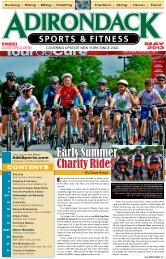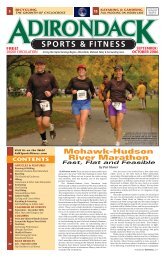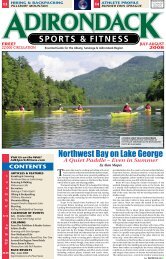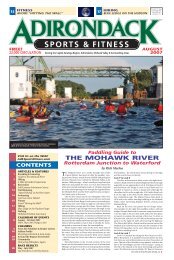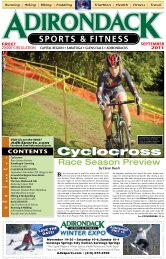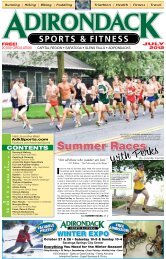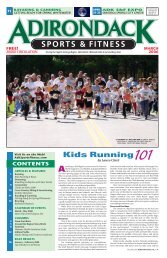WHITEFACE TURNS 50 - Adirondack Sports & Fitness
WHITEFACE TURNS 50 - Adirondack Sports & Fitness
WHITEFACE TURNS 50 - Adirondack Sports & Fitness
Create successful ePaper yourself
Turn your PDF publications into a flip-book with our unique Google optimized e-Paper software.
4 <strong>Adirondack</strong> <strong>Sports</strong> & <strong>Fitness</strong><br />
SWIMMING<br />
BILATERAL BREATHING<br />
From: Donal Fagan<br />
Date: January 29, 2008 11:40am<br />
Last week, while I was doing the 5 x <strong>50</strong><br />
freestyle, I happened to switch between<br />
“breathe alternate sides” and “25 breathe<br />
left, 25 breathe right.” Though I swam with<br />
the same effort, breathe alternate sides was<br />
always a few seconds faster.<br />
From: Grant Hall<br />
Date: January 29, 2008 12:07pm<br />
This is still true for me as well. My conclusion<br />
has been that I have still not completely<br />
mastered a perfectly executed, seamless<br />
breath.<br />
From: Richard Skerrett<br />
Date: January 29, 2008 12:23pm<br />
In my limited experience, I would say<br />
that while breathing alternate sides is highly<br />
benefi cial, breathing to one side on odd<br />
lengths and the other side on even lengths<br />
may be even better. Further, although I<br />
haven’t established it with certainty I think<br />
that I swim better breathing to the “wrong”<br />
side. Perhaps not faster yet, but with a more<br />
effi cient stroke. I must do some timed tests<br />
to compare them.<br />
From: Donal Fagan<br />
Date: January 29, 2008 1:26pm<br />
I did some timed <strong>50</strong>0s a few years ago.<br />
Even though I feel better breathing left,<br />
or alternating breathing side by 25, I was<br />
fastest breathing exclusively to the right. I<br />
never timed alternate breathing for a full<br />
<strong>50</strong>0, though. I’ve only managed that once<br />
or twice.<br />
From: Terry Laughlin<br />
Date: January 29, 2008 10:49pm<br />
This is an excellent series of observations<br />
on the different choices one has for breathing<br />
bilaterally. My introduction to bilateral<br />
breathing came after I had “retired” from<br />
competitive swimming at age 21 to begin<br />
coaching.<br />
Where Winter and Family Fun Come Together!<br />
Over <strong>50</strong> years of skiing in your backyard!<br />
• Affordable Lift &<br />
Tubing Ticket Rates<br />
• 95% Lights &<br />
Snowmaking Coverage<br />
• Terrain & Tubing Parks<br />
& Fun Events<br />
Where life is a journey<br />
Washington County Tourism Association<br />
888.203.8622 • washingtoncounty.org<br />
On my fi rst practice as a coach, I noticed<br />
that nearly my entire team of 15 college<br />
men had lopsided strokes. The left-breathers<br />
swung wider on recovery on the left side<br />
and the right-hand stroke crossed the centerline.<br />
The right-breathers did the opposite.<br />
After pondering what I’d seen that evening,<br />
I decided to experiment with “wrong side<br />
breathing” the next day.<br />
The next day I instructed the team to<br />
breathe on their less natural side throughout<br />
our 800-yard warm-up. Instantly nearly<br />
everyone was far more symmetrical in their<br />
stroking. Being a new coach, I wasn’t exactly<br />
sure why or what the effect of that might<br />
be, but I was pretty sure that “practicing<br />
symmetry” would be good for their swimming.<br />
Thirty-fi ve years later, I’m also pretty<br />
sure that most probably felt awkward and<br />
swam slower during that warm-up though<br />
they looked better. From that day I became<br />
a believer in bilateral breathing during practice<br />
though I didn’t insist on it during races.<br />
I was still swimming a bit myself at<br />
that time (I didn’t resume regular training<br />
for another 17 years) and I began breathing<br />
alternate sides. Breathing to the right<br />
felt awkward, but I kept at it. For the next<br />
25 years my bilateral breathing was mostly<br />
alternate sides – every 3, 5 or 7 strokes.<br />
As I approached my <strong>50</strong>th birthday, I<br />
became dissatisfi ed with the fact that my<br />
right-hand catch never felt as good as my left.<br />
I understood why. For my fi rst ten years of<br />
swimming, a period when I gave little thought<br />
to technique, I’d developed many bad habits.<br />
Several – poor alignment and “collapsing<br />
Hours: Tue 3:30-10/adult night,<br />
Wed/Thu 10-9, Fri 10-10, Sat/Sun 9-6<br />
Mon closed except holidays<br />
Hours change during holiday weeks<br />
Off NY Rte 40, Easton (near Greenwich) – Only 30-40 min from Saratoga & Albany<br />
(518) 692-7337 • willardmountain.com<br />
by Terry Laughlin<br />
catch” on my right side – were related to my<br />
being a left-breather. My other side had never<br />
developed bad habits so it was “virgin.”<br />
In my late 40s I decided to breathe mostly<br />
to my right for a year or two, to somewhat<br />
compensate for breathing exclusively left for<br />
my fi rst 10 years as a swimmer. It was challenging<br />
at fi rst, because it felt unnatural.<br />
Breathing alternate sides, even for 20-plus<br />
years, had not exposed me to the sense of<br />
full-time awkwardness one gets from breathing<br />
hundreds of times in a row to one’s less<br />
natural side. But my alignment and catch on<br />
both sides were unquestionably better when<br />
I breathed only to the right.<br />
Consequently I had immediate, measurable<br />
gains in effi ciency, taking one less<br />
stroke-per-length in 25-yard pools and two<br />
to three less in <strong>50</strong>-meter pools. I didn’t time<br />
myself too much in the beginning, but I was<br />
probably a bit slower.<br />
I was comfortable with what I was sure<br />
would be a temporary sacrifi ce in speed,<br />
because concentrated right-breathing<br />
seemed the only way to reeducate my right<br />
hand to an effective catch. Which is precisely<br />
what occurred – my right hand is still not<br />
quite as “patient” as my left, but it’s dramatically<br />
better than before.<br />
I take an estimated half-million freestyle<br />
strokes a year. A quarter-million of those<br />
strokes – all those I take with my right hand<br />
– feel markedly more effective now than<br />
eight years ago because I spent a year or two<br />
breathing mainly to my right, followed over<br />
the past six years, taking a roughly equal<br />
number of breaths to each side.<br />
30th<br />
Anniversary!<br />
PHOTO COURTESY OF TOTAL IMMERSION SWIMMING<br />
This year I’ve resumed breathing more<br />
often to the left, my original side. Why?<br />
Because I’m still unquestionably faster when I<br />
breathe left, but after so many years of “remedial”<br />
breathing I’m now a much more effi cient<br />
swimmer whichever side I breathe on.<br />
Try These Exercises in “Examined”<br />
Bilateral Breathing<br />
� Swim three rounds of “4 x <strong>50</strong>” freestyle. Rest<br />
for fi ve or more deep, slow “cleansing” breaths<br />
between <strong>50</strong>s – or choose an interval that<br />
allows at least 15 seconds recovery between<br />
<strong>50</strong>s. Rest for a minute between rounds.<br />
� In each round, swim one <strong>50</strong> of each: breathe<br />
to your left for the entire <strong>50</strong>; breathe to your<br />
right for the entire <strong>50</strong>; breathe to your left for<br />
25 and your right for 25; and breathe bilaterally<br />
(every three strokes) for the entire <strong>50</strong>.<br />
� On the fi rst round just count strokes for<br />
each <strong>50</strong>. On the second round, time yourself<br />
for each <strong>50</strong>. On the third round, calculate<br />
your Swim Golf score for each <strong>50</strong> (add<br />
strokes + time in seconds).<br />
Are you more effi cient (fewer strokes) with<br />
one breathing pattern than others? Are you<br />
faster with one breathing pattern than others?<br />
Are you more effective (lower golf score) with<br />
one breathing pattern than others?<br />
Terry Laughlin (totalimmersion.net) is head<br />
coach and founder of Total Immersion<br />
Swimming in New Paltz. This article is<br />
excerpted from his next book, O2 in H2O:<br />
A Guide to Better Breathing Skills, a<br />
companion to Total Immersion’s latest DVD,<br />
O2 in H2O: How to Breathe (Better and<br />
Easier Than Ever) While Swimming.<br />
THE RUNNIN’ OF THE<br />
GREEN (ISLAND)<br />
30th<br />
Anniversary!<br />
Four-Mile Road Race & Kid’s Fun Runs<br />
Saturday, March 8 at 10am (Snow date: March 15)<br />
Village of Green Island, Legnard-Curtin American Legion Hall, 35 Cohoes Ave<br />
Presented by Hudson-Mohawk Road Runners Club,<br />
<strong>Adirondack</strong> Association USATF, and Village of Green Island<br />
Entry Fees – Pre-race: HMRRC member $10; Non-Member $12<br />
All Applications received after March 5 or day of race $15<br />
Application – HMRRC.COM • T-shirts to first 400 runners in main race<br />
Kids’ Fun Runs – $1 race day only (main race at 11:30am – 200m, 400m, 1M)<br />
Awards – Top 3 M/F runners. Top 3 in 5-year age groups.<br />
Top 10 age-graded runners. USATF (must have 2008 USATF number):<br />
Top 5 M/F in Open division; top 3 M/F in 5-year age groups in Masters (40+).<br />
Team: Top 3 USATF-registered open/masters, male/female teams.<br />
Race Director – Ken Skinner: kennyskin@earthlink.net<br />
HMRRC Grand Prix & <strong>Adirondack</strong> Association USATF Championship Race<br />
New HMRRC & USATF policy: No headphones or iPods worn/listened to in race




